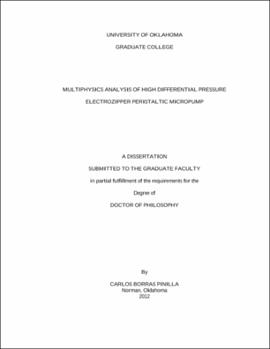| dc.contributor.advisor | STALFORD, HAROLD L | |
| dc.creator | Borras Pinilla, Carlos | |
| dc.date.accessioned | 2019-04-27T21:21:16Z | |
| dc.date.available | 2019-04-27T21:21:16Z | |
| dc.date.issued | 2012 | |
| dc.identifier | 99122855502042 | |
| dc.identifier.uri | https://hdl.handle.net/11244/318483 | |
| dc.description.abstract | The problem investigated in this dissertation is that of designing and developing a micropump for on-chip applications that have requirements for simultaneous high differential pressures and high flow rates, particularly for gas flow applications. In the literature, there are designs that provide high differential pressures at low flow rates and there are designs that provide for high flow rates at low differential pressures. Developing on-chip design solutions for both simultaneously is currently a wide open research area. It is a challenging research area in nanotechnology and microelectromechanical systems (MEMS) to develop on-chip micropump solutions that provide for simultaneous high differential pressures and high flow rates. The research in this dissertation considered this interesting and challenging research problem and focused its thesis on developing such performance requirementsfor peristaltic micropumps using the so-called "electrozipper" mechanism approach. The electrozipper mechanism uses electrostatic forces to bring two surfaces together for pumping fluids by zippering them together by starting at one end and finishing up at the far end, not dissimilar from the result of squeezing out toothpaste from a tube by rolling the tube up. The main pursuit of the research in this dissertation is to derive designs that yield high differential pressures and high flow rates simultaneously, particularly, differential pressures greater than 1 atm (one atmospheric pressure) with flow rates in the range 1-1000 SCCM (cubic centimeters per minute at standard atmospheric conditions). | |
| dc.description.abstract | A critical parameter that limits the performance of electrozipper-based mechanisms is the voltage dielectric breakdown factor of the semiconductor dielectric material used to insulate the voltage potential differences between the two electrozippering surfaces. Silicon dioxide (SiO2) is selected as the dielectric material that has a voltage dielectric breakdown factor greater than 1 volt per nanometer (nm). All micropump designs of this dissertation are limited to 1 volt per nanometer to stay below the voltage dielectric breakdown factor of Silicon dioxide. The baseline value for the dielectric thickness is taken to be 200 nm. As a result, the applied voltage is limited to a maximum of 200 volts. | |
| dc.description.abstract | Baseline design parameters of the micropump chamber geometry include micropump plate radius = 1 mm and chamber height = 20 microns. Micropump plate thicknesses of 2, 4, 6, 8, and 10 microns are considered throughout the investigation. Extensive multiphysics 2D simulations are performed on the baseline configuration for intake and outlet power strokes. One of the contributions of the research work is the development of simulation models for simulating the multiphysics interactions of electrostatics, structures, fluid flow, and moving boundaries of the micropump. Another contribution is the derivation of analytical models for the intake and outlet power strokes. The results from the multiphysics simulations and that from the analytical models are shown to agree within a few per cent for all cases treated. | |
| dc.description.abstract | Another contribution is that of considering preloaded tension (i.e., preloaded residual stresses) in the micropump plate as an additional baseline design parameter and showing that micropump performance (i.e., higher differential pressures and flow rates) is significantly improved under such preloaded conditions. It is shown that preloaded tension in the plate can be used as stored energy to balance out the applied voltage requirements of the intake and power strokes and thereby increase micropump performance and reduce power requirements. With the employment of preloaded residual stress, differential pumping pressures greater than 1.5 atm are shown to be achievable for a 10 micron plate thickness and, for such cases, it is shown that fatigue safety limits are satisfied for multimillions life-cycles. | |
| dc.description.abstract | The new vacuum micropump concept is proposed for the sensor industry to handle large differential pressures (1 atm) at the outlet and achieving very low absolute pressures at the inlet reservoir. The baseline design is shown to provide 10-3Torr vacuum pressures in the presence of leak back rates for plate surface roughness height factors in the range from 1-10 nm. And, it is shown that high vacuum pressures (e.g., 10-6 to 10-9Torr) are achievable by cascading two such micropumps. A detailed method is provided to study different design alternatives for vacuum micropump applications. | |
| dc.description.abstract | Non-dimensional ratios in the analytical equations are used to extrapolate the performance of designs beyond that of the baseline configuration and tailor designs for particular differential pressure/flow rate performances and size requirements. This design approach saves the enormous computational time required by multiphysics simulations. Two designs applications are considered to meet high flow rates with high differential pressures. One is pumping down a 1 Torr inlet reservoir to a 1 atm outlet reservoir and the second application considered is that of pumping a 1 atm inlet reservoir to a 2 atm outlet reservoir. Designs with flow rates in the range 1-1000 SCCM are shown to be achievable | |
| dc.format.extent | 337 pages | |
| dc.format.medium | application.pdf | |
| dc.language | en_US | |
| dc.relation.requires | Adobe Acrobat Reader | |
| dc.subject | Microelectromechanical systems | |
| dc.subject | Microfluidics | |
| dc.subject | Nanotechnology | |
| dc.title | MULTIPHYSICS ANALYSIS OF HIGH DIFFERENTIAL PRESSURE ELECTROZIPPER PERISTALTIC MICROPUMP | |
| dc.type | text | |
| dc.type | document | |
| dc.thesis.degree | Ph.D. | |
| ou.group | College of Engineering::School of Aerospace and Mechanical Engineering | |
